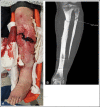Osteocutaneous Turn-Up Fillet Flaps: A Spare-Parts Orthoplastic Surgery Option for a Functional Posttraumatic Below-Knee Amputation
- PMID: 37808330
- PMCID: PMC10556299
- DOI: 10.1055/a-2033-5803
Osteocutaneous Turn-Up Fillet Flaps: A Spare-Parts Orthoplastic Surgery Option for a Functional Posttraumatic Below-Knee Amputation
Abstract
This article portrays the authors' experience with a complex lower limb bone and soft tissue defect, following chronic osteomyelitis and pathological fracture, which was managed by the multidisciplinary orthoplastic team. The decision for functional amputation versus limb salvage was deemed necessary, enhanced by the principles of "spare parts" in reconstructive microsurgery. This case describes the successful use of the osteocutaneous distal tibia turn-up fillet flap that allowed "lowering the level of the amputation" from a through knee to a below-knee amputation (BKA) to preserve the knee joint function. We comprehensibly review reports of turn-up flaps which effectively lower the level of amputation, also applying "spare-parts" surgery principles and explore how these concepts refine complex orthoplastic approaches when limb salvage is not possible to enhance function. The osteocutaneous distal tibia turn-up fillet flap is a robust technique for modified BKA reconstructions that provides sufficient bone length to achieve a tough, sensate stump and functional knee joint.
Keywords: below knee amputation; fillet flap; osteocutaneous flap; spare-parts surgery.
The Author(s). This is an open access article published by Thieme under the terms of the Creative Commons Attribution License, permitting unrestricted use, distribution, and reproduction so long as the original work is properly cited. ( https://creativecommons.org/licenses/by/4.0/ ).
Conflict of interest statement
Conflict of Interest None declared.
Figures




References
-
- MacKenzie E J, Bosse M J, Castillo R C et al.Functional outcomes following trauma-related lower-extremity amputation. J Bone Joint Surg Am. 2004;86(08):1636–1645. - PubMed
-
- Williams Z F, Bools L M, Adams A, Clancy T V, Hope W W. Early versus delayed amputation in the setting of severe lower extremity trauma. Am Surg. 2015;81(06):564–568. - PubMed
-
- Azoury S C, Stranix J T, Kovach S J, Levin L S. Principles of orthoplastic surgery for lower extremity reconstruction: why is this important? J Reconstr Microsurg. 2021;37(01):42–50. - PubMed
-
- Eldridge J C, Armstrong P F, Krajbich J I. Amputation stump lengthening with the Ilizarov technique. A case report. Clin Orthop Relat Res. 1990;(256):76–79. - PubMed
-
- Majumdar K, Lenka P K, Mondal R K, Kumar R, Triberwala D N. Relation of stump length with various gait parameters in trans-tibial amputees. Online J Health Allied Sci. 2008;7(02):2.
LinkOut - more resources
Full Text Sources

